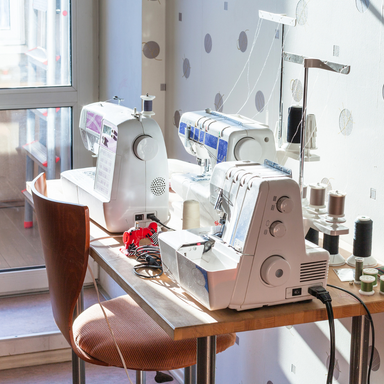Posted by Wicked Fabrics - Vivi Richards on 9th Oct 2024
A Guide to Choosing Your First Sewing Machine: Beginner Sewists
Read Time: 3m 20s
Starting your sewing journey is an exciting adventure, and choosing the right sewing machine is an important first step. This guide will take you through the history of sewing machines, compare low-cost and high-end options, and provide useful information to help you make an informed decision.
A Brief History of Sewing Machines
Understanding the evolution of sewing machines can help you gain a greater appreciation for these amazing machines.
1830s: The birth of the sewing machine
- Barthélemy Thimonnier patented the first functional sewing machine in 1830
- Elias Howe developed the lockstitch mechanism in 1845
1850s-1860s: The sewing machine revolution
- Isaac Singer improved existing designs and began mass production
- The "Sewing Machine War" patent battle led to the Sewing Machine Combination, a patent pool that accelerated innovation
1870s-1900s: Refinement and diversification
- Development of electric sewing machines
- Introduction of specialised machines for industrial use
1900s-Present: Modern innovations
- Computerised sewing machines introduced in the 1970s
- Embroidery machines and overlockers became more accessible to home sewists
This rich history has resulted in a wide range of sewing machines available today, from basic mechanical models to advanced computerised systems.
Types of Sewing Machines for Beginners
Mechanical Sewing Machines:
- Manual operation with dials and knobs
- Typically more affordable
- Easier to maintain and repair
- Limited stitch options
Electronic Sewing Machines:
- Computerised controls with LCD screens
- More stitch options and automated features
- Often include one-step buttonholes and automatic needle threaders
- Generally pricier than mechanical machines
Computerised Sewing Machines:
- Advanced features like stitch memory and programmable patterns
- Touchscreen interfaces and USB connectivity
- Extensive stitch libraries
- Higher price point
Key Features to Consider for Beginners
Stitch Options:
- Look for machines with essential stitches: straight, zig-zag, buttonhole etc
- 10-20 built-in stitches are usually sufficient for beginners
Ease of Use:
- Clear instructions and intuitive controls
- Automatic needle threader
- Top-loading bobbin with clear cover
Adjustability:
- Adjustable stitch length and width
- Tension control
- Presser foot pressure adjustment
Build Quality:
- Metal frame for stability
- Smooth operation and low vibration
Accessories:
- Various presser feet (zipper foot, buttonhole foot, etc.)
- Seam ripper, bobbins, and needles
- Hard cover or carrying case
Budget-Friendly vs. High-End Machines
Budget-Friendly Machines (Under $400):
Pros:
- More affordable initial investment
- Suitable for basic sewing tasks
- Often simpler to operate
- Good for occasional use or beginners unsure of their commitment
Cons:
- Limited features and stitch options
- May have plastic components, affecting durability
- Potentially louder operation
- Might struggle with thick fabrics
Mid-Range Machines ($400-$1000):
Pros:
- Balance of features and affordability
- More stitch options and automated features
- Better build quality than budget models
- Suitable for growing skills
Cons:
- May lack advanced features of high-end models
- Potentially less durable than premium machines
High-End Machines ($1000+):
Pros:
- Extensive stitch libraries and advanced features
- Superior build quality and durability
- Quieter operation
- Better handling of diverse fabrics
- Often include extended warranties
Cons:
- Higher initial investment
- May have features beginners won't initially use
- Steeper learning curve for advanced functions
Tips for Choosing Your First Sewing Machine
Assess your needs:
- Consider the types of projects you plan to tackle
- Think about your long-term sewing goals
Set a realistic budget:
Remember to factor in the cost of accessories and notions.
Try before you buy:
- Visit local sewing machine dealers to test different models
- Pay attention to noise levels and ease of use
Research brands and models:
- Read reviews from other beginners
- Look for machines with good customer support
Consider portability:
If you plan to take classes or sew in different locations, choose a lighter model.
Check warranty and support:
- Look for machines with at least a 1-year warranty but extended warranty is best
- Ensure availability of local repair services
Common Mistakes to Avoid
Buying the cheapest option available:
Invest in quality to avoid frustration and frequent replacements.
Opting for the most feature-packed machine:
As a beginner, you may not need all the bells and whistles plus learning all the features can be overwhelming.
Ignoring ergonomics:
Ensure the machine is comfortable to use for extended periods.
Overlooking the importance of customer support:
Choose brands with reliable customer service and readily available parts in your local area is important.
Neglecting to consider your sewing space:
Make sure the machine fits comfortably in your designated sewing area.
Choosing your first sewing machine is an exciting step in your creative journey. By taking into account your needs, budget, and long-term goals, you can choose a machine that will evolve with you as your skills improve. Remember that the best sewing machine for you is one you'll use frequently and enjoy operating. Whether you choose a low-cost mechanical model or a high-end computerised machine, the most important thing is to start sewing and expressing your creativity. Happy sewing, and may your new machine be the start of many rewarding projects!



